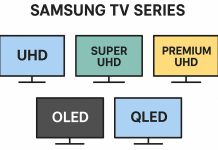In the description of some TVs, if you read the specifications, in the “Audio” section you can find the following information, namely support for DTS 2.0 + Digital Out sound; many people think that the device supports DTS sound, but it does not.
What is DTS 2.0 + Digital Out
Suppose you see DTS 2.0 + Digital Out or DTS + Digital Out support in the specifications. In this case, the TV can receive DTS-encoded digital audio and send it to an optical or coaxial (digital) audio output for playback on an external audio device. The TV cannot play DTS audio if the specifications state that only DTS 2.0+Digital Out is supported.
How is DTS sound reproduced in this case? The TV receives the sound via HDMI cable; HDMI transmits the video and sound; once the TV receives the digital sound, it either outputs it unprocessed via digital coaxial cable, but most often, the sound is converted to light and sent to an optical audio output. For example, the sound comes from the player via HDMI to the TV, and the TV sends it to a digital audio receiver, soundbar, or home theater that supports DTS. The soundbar decodes the sound with a codec and sends it to the speakers.
How do I know if my TV has a DTS codec or not?
Suppose your TV’s specifications say that the DTS audio format is supported. The TV can decode and play the DTS audio format using a DTS decoder. There are two variants of audio decoding: in the first case, audio codecs are built into the TV software, and in the second case, a separate audio processor is used. How the audio playback scheme is implemented depends on the TV developer. However, most people prefer to use separate audio processors because it reduces the load on the central processor and allows you to achieve smoother image output.
How the TV outputs sound in DTS or Dolby format
The DTS and Dolby formats support multiple sound channels, such as six sound channels and 5+1 (five channels of sound, front, left-right, and two rear + subwoofer), but most TVs only have two speakers. Of course, premium TVs can have many speakers and output all the sound channels.
However, if a TV has only two speakers, the signal is decoded and output to the speakers, and the rear channels of sound are usually not played.






